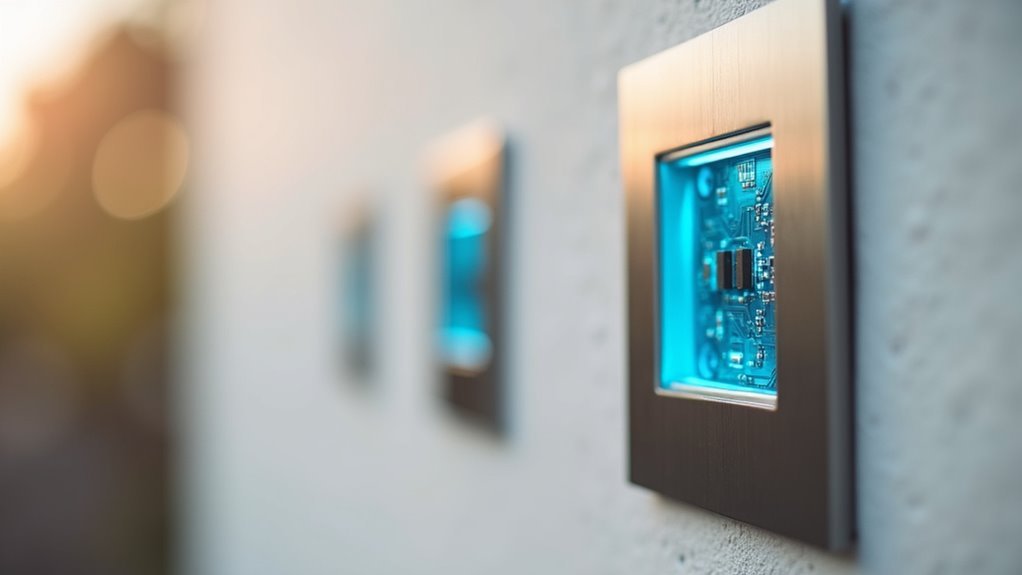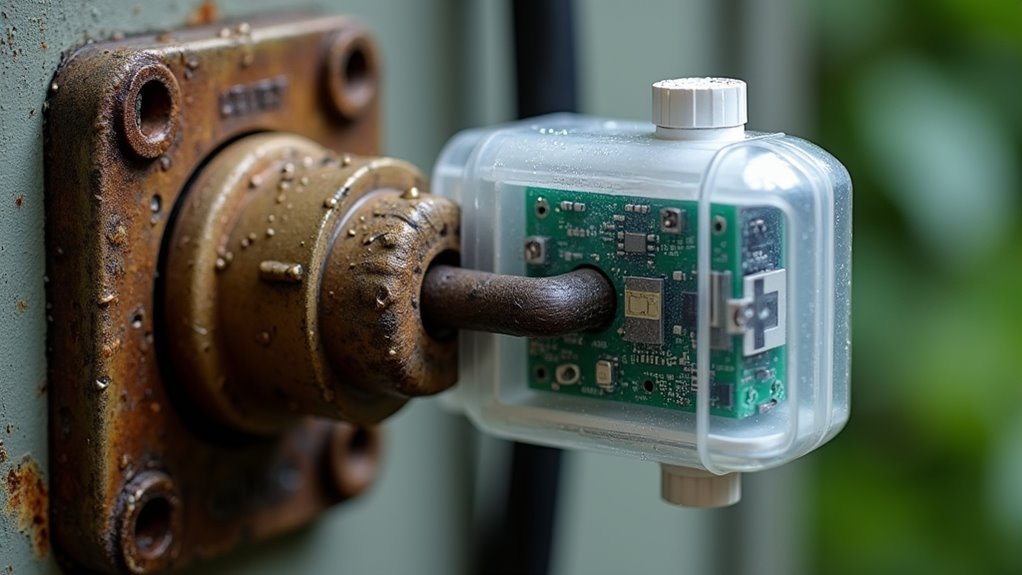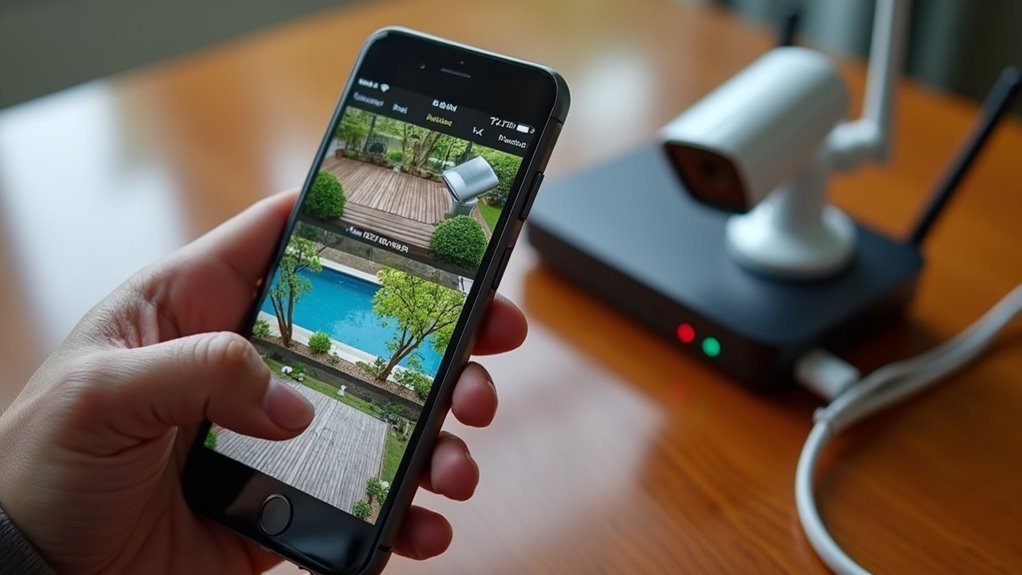You’re probably wondering if converting your traditional outlets to low voltage smart systems is worth the investment and effort. While most homeowners stick with standard 120V outlets, there’s a compelling case for making the switch that goes beyond simple convenience. The combination of enhanced safety, reduced energy costs, and seamless integration with modern renewable energy sources creates opportunities you might not have considered—but there’s more to this decision than meets the eye.
Safety Benefits of Low Voltage Smart Systems

When you’re considering electrical upgrades for your home, low voltage smart outlets offer compelling safety advantages that conventional high-voltage systems can’t match.
Operating below 55 volts, these systems greatly reduce your risk of electric shock and electrocution. You’ll experience enhanced energy efficiency since low voltage technology minimizes power loss during transformation.
Your smart home becomes notably safer with reduced fire hazards, as low voltage systems generate less heat and require fewer safety precautions.
When you integrate renewable energy sources like solar panels, these systems operate more effectively while maintaining superior safety standards.
Built-in safeguards and electrical code compliance guarantee your family’s protection.
You’re investing in technology that prioritizes safety without compromising performance or functionality.
Energy Efficiency Advantages Over Traditional High Voltage
You’ll notice significant energy savings when you switch from traditional high voltage outlets to low voltage smart alternatives.
Your home’s power consumption drops considerably because low voltage devices require less electrical energy to operate effectively.
You’ll also benefit from reduced energy transformation losses, as lower voltage systems generate less heat during power conversion, making your entire electrical system more efficient.
Reduced Power Consumption
Because low voltage systems operate at considerably lower energy levels than traditional high voltage alternatives, you’ll experience reduced power consumption and noticeably lower electricity bills.
When you install a low voltage smart outlet, you’re choosing a system that minimizes energy waste during power transformation, making your home more efficient.
Here are four key benefits of reduced power consumption with low voltage systems:
- Lower energy draw – Devices connected to low voltage smart outlets consume markedly less electricity.
- Minimal transformation losses – Less energy gets wasted during voltage conversion processes.
- LED compatibility – Perfect for energy-efficient LED lighting that uses a fraction of traditional power.
- Renewable integration – Seamlessly works with solar panels for optimized energy utilization and maximum cost savings.
Lower Energy Transformation Losses
While traditional high voltage systems waste substantial energy during power transformation, low voltage smart outlets operating at 12V to 48V dramatically reduce these losses through basic electrical principles.
You’ll benefit from markedly lower resistive losses since energy loss equals current squared times resistance. When your smart outlet reduces voltage, it decreases current flow, minimizing wasted energy during transformation.
This efficiency translates directly into reduced electricity bills and a smaller carbon footprint for your home.
You’ll also discover that low voltage systems integrate seamlessly with renewable energy sources like solar panels, which naturally produce low voltage direct current.
Smart Home Integration and Control Options

Smart home integration transforms how you control and monitor your electrical devices, and low voltage smart outlets serve as the foundation for this connected ecosystem.
These smart outlet solutions operate seamlessly with popular protocols like Z-Wave and Wi-Fi, enabling thorough automation throughout your home.
Low voltage smart outlets offer diverse control options:
- Remote Operation – Control devices from anywhere using smartphone apps or web interfaces
- Voice Assistant Compatibility – Integrate with Alexa and Google Home for hands-free control
- Automated Scheduling – Program devices to operate based on time schedules or triggers
- Energy Monitoring – Track usage patterns and optimize consumption for cost savings
Smart Plug technology with Matter support guarantees interoperability between manufacturers, creating a unified control experience that streamlines your entire smart home ecosystem.
Installation Requirements and Wiring Considerations
Although low voltage smart outlets offer tremendous convenience and control, proper installation requires careful planning and adherence to specific wiring requirements.
You’ll need compatible smart switches that operate at minimum 100V with neutral wire connections. While you can often use existing wiring, carefully assess your current setup to guarantee safety and compatibility.
Check local electrical codes to determine permissible installation practices, especially for outdoor or damp locations.
Use high gauge wire for long runs to minimize voltage drop and guarantee efficient power delivery.
Unlike high voltage systems, low voltage installations still require GFCI protection outdoors – achieve this through inline GFCI devices or GFCI breakers at your panel to prevent electrical hazards.
Equipment Selection for Outdoor Applications

Once you’ve mastered the installation fundamentals, selecting the right equipment for outdoor low voltage smart outlets becomes your next priority.
Your outdoor plug installations demand components that’ll withstand harsh weather while maintaining reliable performance.
Essential equipment considerations include:
- Weather-rated transformers and wiring – Choose components specifically rated for outdoor use to prevent deterioration from extreme conditions.
- GFCI protection integration – Install Ground Fault Circuit Interrupter protection to guarantee safety compliance and prevent electrical shocks.
- Direct bury low-voltage wire – Select underground-rated cables that don’t require additional conduit, simplifying your voltage lighting installations.
- Waterproof junction boxes and connections – Use moisture-resistant enclosures to protect wiring joints and prevent short circuits that compromise system reliability.
Quality outdoor-rated components from reputable manufacturers minimize maintenance requirements while maximizing your smart outlet system’s longevity.
Compatibility With Solar Power and Battery Storage
You’ll find that low voltage smart outlets excel at DC system integration since they can directly utilize the natural current from your solar panels without requiring energy-consuming conversions.
This compatibility eliminates the typical AC-to-DC transformation losses that occur with standard electrical systems.
Your battery storage systems will operate more efficiently when paired with these outlets, creating a seamless energy flow from solar generation through storage to final use.
DC System Integration
Three key advantages make low voltage smart outlets exceptionally compatible with DC solar and battery systems.
You’ll eliminate energy losses that occur when converting between AC and DC power, since your solar panels and batteries naturally operate in DC. This direct compatibility streamlines your energy flow and maximizes efficiency.
Your low voltage smart outlet integration offers these benefits:
- Reduced conversion losses – DC-to-DC systems operate at 90-95% efficiency compared to 80-85% with AC conversion
- Simplified wiring – Direct connection eliminates inverters and transformers between components
- Enhanced battery performance – Native DC operation extends battery life and charging cycles
- Smart device compatibility – Most modern electronics internally use DC power anyway
You’ll create a more efficient, cost-effective renewable energy system that’s perfectly suited for today’s smart home applications.
Energy Storage Efficiency
When your solar panels generate DC power, low voltage smart outlets create a seamless energy storage pathway that maximizes every watt you produce.
You’ll eliminate costly inverter conversions that typically waste 5-15% of your energy during AC transformation. Your battery storage system operates more efficiently because it naturally stores DC power, creating perfect compatibility with your low voltage smart outlet network.
You’ll reduce distribution losses markedly since low voltage wiring minimizes resistance-related energy waste throughout your home’s electrical system.
This means more of your generated solar power actually reaches your devices and storage batteries. Your smart outlet system optimizes charging cycles and energy allocation, ensuring you’re storing maximum power during peak generation hours while maintaining consistent availability for your household needs.
Cost Analysis and Long-Term Savings
While initial investment costs might give you pause, low voltage smart outlets deliver substantial savings that quickly offset their upfront price.
Your cost analysis should consider both immediate and long-term savings potential.
Smart low voltage systems reduce your electricity bills through several mechanisms:
- Lower power consumption – These outlets typically use less energy than standard 120V systems.
- Reduced installation costs – You’ll need less heavy-duty wiring and fewer expensive components.
- Enhanced energy efficiency – Minimized transformation losses save you 5-10% on energy waste.
- Remote control capabilities – Smart scheduling and monitoring can cut energy costs by up to 30%.
When you integrate renewable energy sources like solar panels, your long-term savings multiply considerably, reducing grid dependence while maximizing sustainability benefits.
Frequently Asked Questions
Why Use High Voltage Instead of Low Voltage?
You’ll need high voltage because it powers energy-intensive appliances, guarantees smart device compatibility, reduces transmission losses over distances, and meets safety regulations for permanent installations requiring substantial power loads.
Why Would an Outlet Have Low Voltage?
You’d use low voltage outlets for enhanced safety, especially around water or children. They’re perfect for landscape lighting, smart home devices, and audio systems while reducing shock risks and supporting energy-efficient renewable power sources.
Why Is Low Voltage Better?
You’ll enjoy enhanced safety from reduced shock risk, better energy efficiency with less power loss, easier renewable energy integration, simplified installation with fewer regulations, and seamless compatibility with smart home devices.
Are Low Voltage Lights Worth It?
You’ll find low voltage lights worth the investment because they’re safer, more energy-efficient, and last substantially longer than traditional bulbs while offering versatile design options and smart home integration capabilities.





Leave a Reply